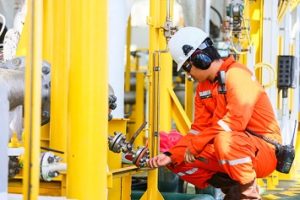Between 2010 and 2014, nine workers in the oil and gas industry died of what were initially determined to be “natural causes.” But the explanation was unsatisfactory—the men were young and healthy and had been found dead for no apparent reason after working alone, either gauging fluid levels or drawing samples from oilfield tanks.

curraheeshutter / iStock / Getty Images Plus / Getty Images
In May 2014, the National Institute for Occupational Safety and Health (NIOSH) flagged the job that the men had been doing as potentially deadly. At that time, the agency launched a yearlong investigation into the workers’ deaths. Its findings led to a change, finalized in late 2016, in the rules governing how employers are permitted to conduct gauging and sampling operations.
What’s Killing Workers?
After ruling out hydrogen sulfide (H2S) exposure, NIOSH turned its suspicions to the volatile hydrocarbons inside the tanks. Before 2012, these hydrocarbons would have been continuously vented to the atmosphere. In 2012, though, the Environmental Protection Agency changed its rules and began requiring oilfield operators to capture hydrocarbons coming out of well sites.
As a result, the hydrocarbons now collect inside the tanks, under pressure. When workers opened the hatches to determine the quantity and quality of crude oil, high concentrations of hydrocarbon gases and vapors were released in a toxic, oxygen-displacing plume.
The agency discovered that the hydrocarbon plume has the potential to be acutely toxic. Volatile hydrocarbons can affect the eyes, respiratory system, and nervous system; at high concentrations, they can cause abnormal heart rhythms. Not all workers are killed by the exposure.
When NIOSH began looking into the problem, it found that tank workers frequently reported symptoms of exposure that included dizziness, fainting, headaches, and nausea when they opened the hatches to do their jobs.
A Solution—and a Barrier
Once NIOSH had identified the hazard, the industry reacted quickly. In 2016, the American Petroleum Institute (API) developed and published a new safety standard, the Custody Transfer of Crude Oil from Lease Tanks Using Alternative Measurement Methods, contained in the API Manual of Petroleum Measurement Standards (API 18.2).
The new standard described alternative methods for measuring the quantity and quality of crude oil without opening the tank hatch, thus protecting workers from exposure to hydrocarbon gases and vapors.
Implementation of the new method was cumbersome at first, requiring employers to apply for variances from the federal Bureau of Land Management (BLM). Then, in October 2016, the BLM updated its rules for oil measurement on federal and Indian leases for the first time in more than 25 years. The new regulation incorporates the API standard, eliminating the need for variances and creating a more streamlined process for approving new technology as it is developed.
Safer Gauging Methods
The changes recommended in API 18.2 and adopted by the BLM include two existing methods for measuring the quantity and quality of crude oil without opening the tank hatch, as well as provisions to allow quicker adoption of new technologies. Employers will now be allowed, without obtaining a variance, to use:
- Coriolis measurement systems (CMSs). A CMS is a metering system that uses a Coriolis flow meter in conjunction with a tertiary device, pressure transducer, and temperature transducer to derive and report gross standard oil volume.
- Automatic tank gauging (ATG). ATG systems have been used by the industry for internal inventory purposes for more than 10 years. Recently, operators have started using them to measure oil for sales and royalty-determination purposes.
Under its new process for approving measurement technologies, which will be implemented over a 2-year period, the BLM has created a Production Measurement Team (PMT) to review measurement technologies. Once those technologies are demonstrated to be reliable and accurate, the BLM can approve them not just for use by a single employer but also nationwide.
Tip: Instead of specifying procedures that may become outdated, the new BLM rule requires operators to follow applicable industry standards in many cases.
